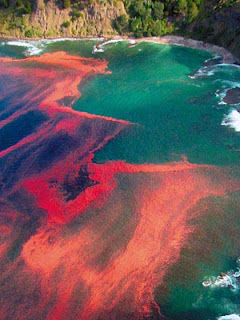Many side effects include disruption of food chain. If we manually shift the phytoplankton community composition, the other species might not be able to adapt to this rapid bloom. Ocean fertilization can also worsen ocean acidification problem and cause oxygen depletion in the deep ocean. Some scientists suspect that ocean fertilization can provoke harmful algae bloom that produce ammonia toxic to many marine species. These toxins are brought up the food chain through the consumption of primary, secondary and tertiary consumers. This could cause implications to food security and human health because we consume seafood as food.
 |
| Harmful Algae Bloom http://www.whoi.edu/cms/images/5_47876.jpg |
Recent experiments are carried out to test the idea of inducing phytoplankton bloom but not so much about the side effects. To get a better understanding on impacts of ocean fertilization, more extensive research and actual experiments are required.
Overall this blog is off to a good start. Below are my comments and suggestions:
ReplyDelete- The introduction tab is not formal enough; I believe that a more thorough description of climate change and warming trends is needed instead of a simplification of the issue (since so much is still unknown)
- Along those same lines, your suggestions to reduce global warming on this tab seem simplistic and misleading. This may reduce contributions to GHG emissions, but this is not a direct commentary on what to expect from the future and how we can help phytoplankton specifically.
- The figures helped to support topics
- On final draft, citations are needed from primary readings from class
- Those citations must also connect back to at least two topics from class (it seems this draft still is being worked on, so be sure those components are added eventually)
- A little more explanation of your terms would be helpful; basically just some elaboration for a reader who does not have knowledge of this issue already
On this page, I like how you talked about a possible remedy that was tried and failed. I suggest adding a little more about what can be done to fight against climate change on the national and global level in addition to the personal level that you have.
ReplyDeleteOverall I also think this blog has a really solid start. There are a few typos and wording errors here and there that I think, if fixed, would make it easier to read on the whole, as would possibly breaking up or dividing the text into sections. You've picked an important topic and I think you do a good job setting up the information, but I would like to see a little more elaboration than what you've got currently on how climate change is affecting the phytoplankton, perhaps you can incorporate some further effects. One small thing also is the white background, it would be nice if you added some color, as it would be a bit easier on the eyes :) Overall, fantastic start, I'm excited for the final version!
ReplyDelete